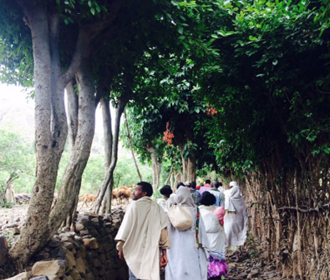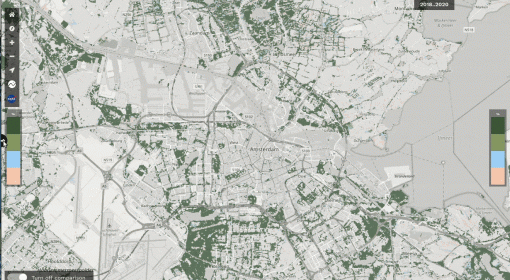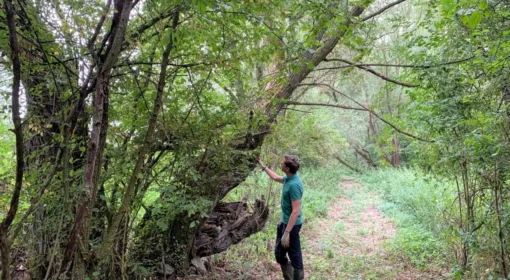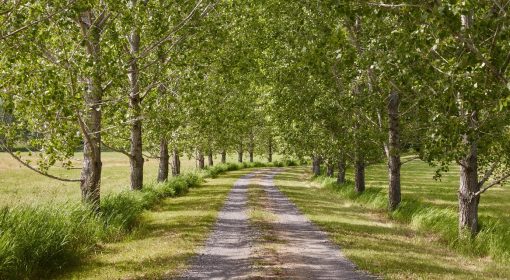By Yuka Nabae
Land use changes, including deforestation and land degradation can disrupt habitats, providing an advantage to species that are adaptable and can thrive in various environments (Kostecka et al., 2018). These adaptable species outcompete those restricted to specific conditions, placing biodiversity (the variation in species, genotypes and ecosystems) at risk under the pressure of such changes. The conversion of semi-natural ecosystems into monocrop agriculture or deforestation further exacerbates the problem, leading to adverse impacts on soil biodiversity (Figuerola et al., 2015).
One promising solution lies in agroforestry and multicropping systems. These approaches intentionally integrate trees and/or shrubs with crops and/or livestock, not only boosting farm productivity but also supporting biodiversity conservation, enriching soil quality, sequestering carbon, and improving water quality (Levin, 2022; Jose, 2019). Additionally, the incorporation of trees and shrubs offers the potential to enhance the income of smallholder farmers, while also bolstering food security through the provision of farm tools, timber, fuelwood, and fruits.
This blog aims to explore the transition from deforestation and monocropping to agroforestry and multicropping systems, particularly in the context of Ethiopia. By doing so, we can positively impact biodiversity conservation and contribute to the sustainable management of natural resources in the region, mitigating the adverse effects of deforestation and land degradation while promoting a more resilient and sustainable agricultural system.
Positive effects of agroforestry on biodiversity
Using regenerative agricultural practices like agroforestry and crop rotation could be crucial for conserving biodiversity in the long run. A study found that soil samples from soybean monoculture had much lower β-diversity (diversity between communities) compared to the multicropping system. Interestingly, the multicropping system showed a level of β-diversity similar to that of natural grasslands (Figuerola et al., 2015).
Agroforestry plays three crucial roles in conserving biodiversity:
- Habitat Provision – Agroforestry systems offer diverse suitable habitats for various species, including insects, birds, mammals, and soil organisms. The system’s varied structure and composition create niches for different species to thrive (Jose, 2019 ; Gillespie et al., 1995 ;Söderström et al.,2001). As a result, agroforestry keeps many species in the arable land while ensuring that forests provide food and security for a variety of species (Nair et al., 2021).
- Connectivity and Corridors – Agroforestry systems act as connectivity corridors between fragmented habitats, facilitating the movement of area-sensitive species (Jose, 2019). By promoting the integrity of remaining habitats, agroforestry supports the conservation of biodiversity. Grass corridors, for example, can serve as functional pathways for species like wasps.
- Ecosystem Services – Agroforestry practices can contribute to the delivery of ample ecosystem services. They can, amongst others, help to control erosion and improve water recharge. Trees enhance soil physical, chemical, and biological properties by adding significant above (littler) and belowground (root) organic matter and releasing and recycling nutrients in the field. This improves soil aggregate stability, increasing the soil’s water retention capacity. Agroforestry can also play a role as windbreaks. The benefits include reducing wind chills, removing atmospheric carbon dioxide and producing oxygen, reducing wind velocity, limiting wind erosion and particulate matter in the air, and reducing noise pollution (Jose., 2019). This helps maintain the ecosystem of surrounding habitats and prevent degradation. These services preserve biodiversity by creating favourable climatic conditions for various species. There is empirical evidence that complex forest structure and vegetation diversity confer microclimatic advantages to some animal populations in the face of climate change (Kim et al., 2022).
Zooming in on Ethiopia
Agroforestry practices have a long-standing history in Ethiopian farming systems, particularly in the semi-arid and sub-humid zones (Kindeya, 2004). Ethiopia is known for its rich biodiversity, with two biodiversity hotspots, the mesic Roof of Africa (Ethiopian Highlands) and the arid Horn of Africa. However, the country faces urgent challenges in preserving its natural areas due to rapid population growth, increasing livestock populations, and the impacts of climate change. Agroforestry has been widely promoted in Ethiopia to overcome crop failure due to climate change and land degradation. National Biodiversity Strategies and Action Plans (NBSAPs) have been implemented and guided the national efforts in preventing nature forests and biodiversity loss from 2015 to 2020. Ethiopian government gave local community with the incentives for generating agroforestry (Government of the Federal Democratic Republic of Ethiopia, 2005). Government of the Federal Democratic Republic of Ethiopia (2020) evaluated traditional knowledge on agroforestry practices are integrated into national policy and- contributed to increase forest cover of the country, 2.6 million ha of land was planted by various trees. For example, indigenous multipurpose agroforestry tree species are intensively being integrated in agroforestry practices in Ethiopia. Despite these progress, the number of indigenous trees in farmland is still seriously decreasing in many local communities (Endale et al., 2017; Habte et al., 2021 ). This is due to a lack of knowledge among local farmers and the inadequate understanding of policymakers in Ethiopia (Lelamo, 2021).
Farmers widely adopt parkland farming systems, and are a dominant feature of agricultural landscapes in Ethiopia (Yadessa et al., 2009). Parkland farming is a form of agroforestry and is often growing trees together with a cereal crop such as maize, teff, or sorghum. This practice involves growing individual trees in wide spaces or scattered and distributed on the farmland without preventing other crops from being grown. Trees planted on farmland are mostly multi-purpose tree species and indigenous trees in Ethiopia. These multi-purpose trees are used for shade, feed, farm tools, timber, fuelwood, cash income, environmental services, and cultural ceremonies, which illustrate the broad contribution farmland agroforestry makes to local livelihoods. Planting multi-purpose tree species in agricultural landscapes also contributes to the existence of various bird species, such as Anomalospiza imberbis and Hirundo aethopica, which have not only biodiversity but also economic value because they disperse seeds and control pests (Amare et al., 2018).
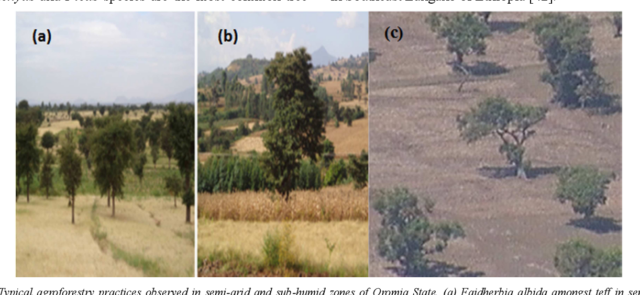
However, the impact of agroforestry on biodiversity can vary based on factors like traditional practices, altitudinal gradients, and socioeconomic dynamics (Tadesse et al., 2021). Due to the interest of the people for fast growth and easily establishment, more people are planting exotic tree species rather than indigenous trees (Habte et al., 2021). This changes the composition of native forest communities. Planting certain exotic species alone can decrease total species richness (Nair et al., 2021). For example, the deliberate choice of species for human consumption, such as coffee, in agroforestry can also potentially reduce overall species diversity.
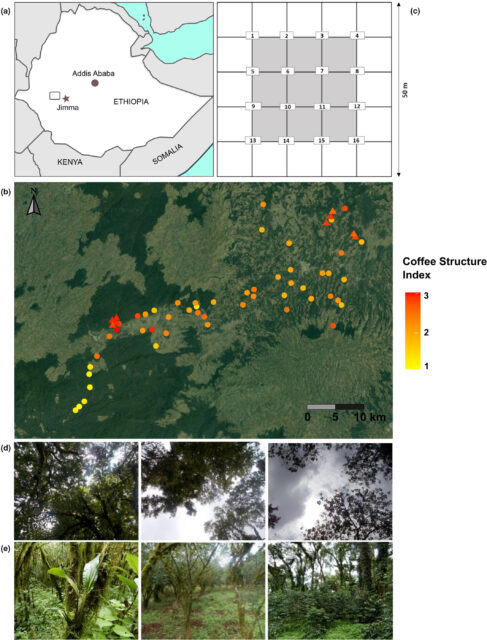
The level of biodiversity differs in natural forests and agroforestry. Recent research on agroforestry and biodiversity showed that the Shannon diversity index has a higher value in the natural forest than the agroforestry (Figure 2). This is because of the high evenness value of the woody species in natural forests. The Shannon diversity index is the most popular index for comparing different habitats’ diversity. This index is based on the proportional or relative abundance of species and is used to characterize diversity in agroforestry. The higher the value of evenness, the more even the species is in their distribution within the sample. The low evenness in agricultural lands (parkland/agroforestry) could be the cause of the dominance of some species in terms of total population, such as Eucalyptus spp., Faidherbia albida, Euclea racemosa and Acacia etbaica which farmers often plant/retain and tend deliberately in high density. In fact, Intensively managed coffee plantations have been found to attract fewer species of insects compared to natural or semi-natural coffee forests (Fashing, P. J., 2022).
| Land use | Shannon diversity index | Evenness |
| Homegarden | 1.31 | 0.39 |
| Agroforestry (parkland) | 1.12 | 0.41 |
| Grazing land | 2.04 | 0.71 |
| Forest land | 2.43 | 0.77 |
Table1: Diversity indices of woody species at different land uses in Ethiopia (Guyassa, Etefa, & Raj, 2013)
Given the increasing global demand for coffee and other food demands, integrating agroforestry into their farming practices is becoming more highlighted in Ethiopia. Traditional knowledge and experience in tree management under different agroforestry systems and methods among farmers can contribute to biodiversity conservation.
Four years ago, the Green Future Farming (GFF) program was launched in Ethiopia to restore degraded landscapes and promote regenerative agriculture and biodiversity. The program used a community-based participatory approach, involving local communities in decision-making processes. The restoration efforts focused on promoting natural regeneration and planting indigenous and agroforestry trees. Under the GFF program, MetaMeta provided technical training and raised awareness about the design and implementation of selected agroforestry practices. The program emphasized the respect for traditional agroforestry practices widely observed in Amhara, one of the regions in Ethiopia. The program took three steps in the region;
- Step 1: Protecting and managing mature trees already present on the site.
- Step 2: Promoting on-site seedlings for further growth by protecting seedlings and young trees since most indigenous tree species are germinated from soil seed banks.
- Step 3: Planting of new tree seedlings. Farmers selected tree species and shrubs based on their adaptability to the local environment, ability to withstand adverse conditions and growth rate. Guiding questions in this step are: 1) What do the farmers want from the tree plantation? 2) What tree species can produce what the farmers want? 3) Will these tree species grow on the land?
By doing this, farmers are encouraged to protect conserved areas, paving the path for scaling up agroforestry in Ethiopia.
Agroforestry and multicropping have thus been recognised as a central practice of regenerative agriculture since it provides additional resources and secures agriculture productivity. Although agroforestry is not always the way to maintain biodiversity as much as nature forest does, it prevents the economic losses associated with land degradation. By planting trees in the farmland, people no longer need to cut down the trees in the forest for their daily needs. Planting multi-purpose indigenous trees on their farmland makes local farmers take the initiative to expand agroforestry and benefit from it. Consequently, agroforestry is helpful to avoid expansion into areas of high carbon stocks (e.g., deforestation) or high biodiversity areas. Raising awareness of agroforestry and understanding the link with biodiversity is key for farmers to uptake regenerative agriculture sustainably and protect natural forests in the long run.
References
- Amare, Dagninet & Wondie, Menale & Mekuria, Wolde & Darr, Dietrich. (2018). Agroforestry of Smallholder Farmers in Ethiopia: Practices and Benefits. Small-scale Forestry. 18. 10.1007/s11842-018-9405-6.
- Yadessa, F. Itanna, M. Olsson (2009).Scattered trees as modifiers of agricultural landscapes: the role of waddeessa (Cordia africana lam.) trees in Bako area, Oromia, Ethiopia Afr. J. Ecol., 47, pp. 78-83
- Endale Bekele Jiru (2019). Review on Agro-forestry System and Its Contribution in Ethiopia. International Journal of Sustainability Management and Information Technologies. Vol. 5, No. 1, pp. 8-14. doi: 10.11648/j.ijsmit.20190501.12
- Endale, Y., Abayneh, D., Mekuria, A., Catherine, M., (2017). Farmland tree species diversity and spatial distribution pattern in Semi-Arid East Shewa, Ethiopia. For. Trees Livelihoods 26, 199–214.
- IPBES (2019): Global assessment report on biodiversity and ecosystem services of the Intergovernmental Science-Policy Platform on Biodiversity and Ecosystem Services. E. S. Brondizio, J. Settele, S. Díaz, and H. T. Ngo (editors). IPBES secretariat, Bonn, Germany. 1148 pages. https://doi.org/10.5281/zenodo.3831673
- 2022. FRA 2020 Remote Sensing Survey. FAO Forestry Paper, No. 186. Rome.
- Fashing, P. J., Nguyen, N., Demissew, S., Gizaw, A., Atickem, A., Mekonnen, A., Nurmi, N. O., Kerby, J. T., & Stenseth, N. C. (2022). Ecology, evolution, and conservation of Ethiopia’s biodiversity. Proceedings of the National Academy of Sciences, 119(50), e2206635119. https://doi.org/10.1073/pnas.2206635119
- Figuerola ELM, Guerrero LD, Türkowsky D, Wall LG, Erijman L. (2015). Crop monoculture rather than agriculture reduces the spatial turnover of soil bacterial communities at a regional scale. Environmental Microbiology. 2015;17:678–688. doi: 10.1111/1462-2920.12497.
- Gillespie AR, Miller BK, Johnson KD (1995) Effects of ground cover on tree survival and growth in filter strips of the Cornbelt Region of the midwestern US. Agric Ecosyst Environ 53:263–270
- Guyassa, Etefa & Raj, Antony Joseph. (2013). Assessment of biodiversity in cropland agroforestry and its role in livelihood development in dryland areas: A case study from Tigray region, Ethiopia. International Journal of Agricultural Technology. 9. 829-844.
- Habte, W., Debissa, L., Dereje, B., 2021. A comparative analysis of indigenous and exotic tree species management practices in agricultural landscapes of southwest Ethiopia. Tree Forest People 4, 100059
- Jose, S. (2009). Agroforestry for ecosystem services and environmental benefits: an overview. Agroforest Syst 76, 1–10 https://doi-org.ezproxy.library.wur.nl/10.1007/s10457-009-9229-7
- Kindeya, G. (2004). Dryland Agroforestry Strategy for Ethiopia. In The Drylands Agroforestry Workshop (p. 26). Nairobi: ICRAF Headquarters.
- Kim, H., McComb, B. C., Frey, S. J. K., Bell, D. M., and Betts, M. G. (2022). Forest microclimate and composition mediate long-term trends of breeding bird populations. Glob. Change Biol. 28, 6180–6193. doi: 10.1111/gcb.16353
- Kostecka et al. (2018) Kostecka J, Mazur-pączka A, Pączka G, Garczyńska M. Lumbricidae biodiversity at the sites in Bieszczady Mountains (Poland) after 25 years. 2018. 19, 125–130.
- Levin, B. (2022). Regenerative Agriculture as Biodiversity Islands. In: Montagnini, F. (eds) Biodiversity Islands: Strategies for Conservation in Human-Dominated Environments.
- Söderström B, Svensson B, Vessby K, Glimskär A (2001) Plants, insects and birds in semi-natural pastures in relation to local habitat and landscape factors. Biodiv Cons 10:1839–1863
- Topics in Biodiversity and Conservation, vol 20. Springer, Cham. https://doi-org.ezproxy.library.wur.nl/10.1007/978-3-030-92234-4_3
- Nair, P.K.R., Kumar, B.M., Nair, V.D. (2021). Agroforestry for Biodiversity Conservation. In: An Introduction to Agroforestry. Springer, Cham. https://doi-org.ezproxy.library.wur.nl/10.1007/978-3-030-75358-0_21
- Tadesse, E., Negash, M. & Asfaw, Z. Impacts of traditional agroforestry practices, altitudinal gradients and households’ wealth status on perennial plants species composition, diversity, and structure in south-central Ethiopia. Agroforest Syst 95, 1533–1561 (2021). https://doi-org.ezproxy.library.wur.nl/10.1007/s10457-021-00659-x
- Torralba M, Fagerholm N, Burgess PJ, Moreno G, Plieninger T (2016) Do European agroforestry systems enhance biodiversity and ecosystem services? A meta-analysis. Agric Ecosyst Environ 230:150–161. https://doi-org.ezproxy.library.wur.nl/10.1016/j.agee.2016.06.002
- Zewdie, B., Tack, A. J., Ayalew, B., Wondafrash, M., Nemomissa, S., and Hylander, K. (2022). Plant biodiversity declines with increasing coffee yield in Ethiopia’s coffee agroforests. J. Appl. Ecol. 59, 1198–1208. doi: 10.1111/1365-2664.14130
